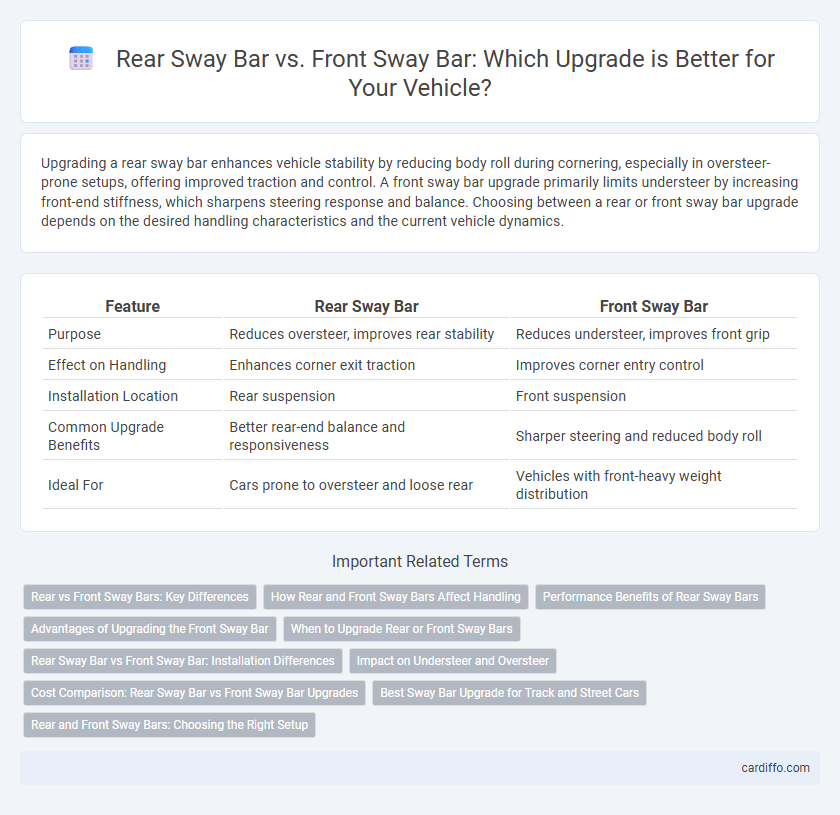Upgrading a rear sway bar enhances vehicle stability by reducing body roll during cornering, especially in oversteer-prone setups, offering improved traction and control. A front sway bar upgrade primarily limits understeer by increasing front-end stiffness, which sharpens steering response and balance. Choosing between a rear or front sway bar upgrade depends on the desired handling characteristics and the current vehicle dynamics.
Table of Comparison
| Feature | Rear Sway Bar | Front Sway Bar |
|---|---|---|
| Purpose | Reduces oversteer, improves rear stability | Reduces understeer, improves front grip |
| Effect on Handling | Enhances corner exit traction | Improves corner entry control |
| Installation Location | Rear suspension | Front suspension |
| Common Upgrade Benefits | Better rear-end balance and responsiveness | Sharper steering and reduced body roll |
| Ideal For | Cars prone to oversteer and loose rear | Vehicles with front-heavy weight distribution |
Rear vs Front Sway Bars: Key Differences
Rear sway bars increase traction and stability during acceleration and corner exit by reducing body roll at the rear suspension, enhancing oversteer control. Front sway bars primarily limit body roll during corner entry, improving understeer resistance and maintaining front tire contact with the road surface. The key difference lies in their effect on vehicle handling balance: rear sway bars influence rear grip and rotation, while front sway bars stabilize the vehicle's front end.
How Rear and Front Sway Bars Affect Handling
Rear sway bars primarily enhance oversteer resistance by reducing body roll in the rear suspension, improving traction and stability during cornering. Front sway bars increase understeer resistance by stiffening the front suspension, allowing for sharper steering response and better road feedback. Optimizing the balance between rear and front sway bars is crucial for achieving precise handling and controlled weight transfer in performance driving.
Performance Benefits of Rear Sway Bars
Rear sway bars enhance vehicle stability by reducing body roll during cornering, improving traction and control on uneven or slippery surfaces. They offer superior balance between oversteer and understeer compared to front sway bars, allowing for improved handling precision in high-performance driving. Upgrading to a stiffer rear sway bar is essential for maximizing cornering grip and responsiveness in sports cars and off-road vehicles.
Advantages of Upgrading the Front Sway Bar
Upgrading the front sway bar enhances vehicle stability by reducing body roll during cornering, leading to improved steering response and better traction on uneven surfaces. A stiffer front sway bar also balances chassis dynamics, promoting more predictable handling in aggressive driving conditions. This upgrade is particularly beneficial for front-wheel-drive vehicles, where it helps manage understeer and increases overall driving confidence.
When to Upgrade Rear or Front Sway Bars
Upgrade rear sway bars when experiencing excessive body roll or understeer during cornering, as they improve rear-end stability and traction. Front sway bar upgrades are essential for reducing oversteer and enhancing front-end responsiveness, particularly in aggressive driving or track conditions. Choose the sway bar to upgrade based on your vehicle's handling imbalance and driving style to achieve optimal performance.
Rear Sway Bar vs Front Sway Bar: Installation Differences
Rear sway bar installation typically involves mounting the bar to the rear axle and chassis using brackets and bushings designed to reduce body roll during cornering. Front sway bars require attachment to the front suspension components, often needing precise alignment with tie rods and control arms to ensure proper handling. Installation complexity varies as rear sway bars generally offer easier access and simpler mounting points compared to the intricate connections and adjustments necessary for front sway bars.
Impact on Understeer and Oversteer
Upgrading the rear sway bar increases rear axle stiffness, significantly reducing understeer by promoting earlier rear tire breakaway and enhancing oversteer balance. In contrast, a stiffer front sway bar raises front roll resistance, intensifying understeer by causing the front tires to lose grip before the rear. Optimizing sway bar settings allows precise manipulation of vehicle handling characteristics for improved cornering stability.
Cost Comparison: Rear Sway Bar vs Front Sway Bar Upgrades
Rear sway bar upgrades generally cost less than front sway bar improvements, with prices ranging from $100 to $300 compared to $150 to $400 for front sway bars. Labor expenses for rear sway bar installation tend to be lower due to easier access and simpler mounting points. Performance-wise, front sway bars usually require higher investment but offer more significant handling benefits, making cost a key factor in upgrade decisions.
Best Sway Bar Upgrade for Track and Street Cars
Upgrading the rear sway bar provides better balance and reduces oversteer, making it ideal for track cars seeking improved cornering stability. The front sway bar enhances front-end stiffness, improving turn-in response and grip on street cars where everyday drivability is crucial. A combined upgrade targeting both bars offers optimal handling performance by fine-tuning understeer and oversteer characteristics for versatile track and street applications.
Rear and Front Sway Bars: Choosing the Right Setup
Rear sway bars improve vehicle stability during cornering by reducing body roll and enhancing rear traction, which is crucial for oversteer control. Front sway bars, on the other hand, primarily help reduce understeer by stiffening the front suspension and improving front-end grip. Choosing the right setup depends on the vehicle's handling characteristics and driving style, with rear sway bars favored for balanced, responsive handling and front sway bars for sharper turn-in and stability.
Rear Sway Bar vs Front Sway Bar Infographic

 cardiffo.com
cardiffo.com